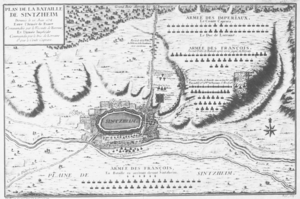Battle of Sinsheim
| Battle of Sinsheim | |||||||
|---|---|---|---|---|---|---|---|
| Part of Franco-Dutch War | |||||||
 |
|||||||
|
|||||||
| Belligerents | |||||||
|
|
|
||||||
| Commanders and leaders | |||||||
| Turenne | Aeneas de Caprara | ||||||
| Strength | |||||||
| 1,500 foot soldiers 6,000 horsemen |
2,000 foot soldiers 7,000 horsemen |
||||||
| Casualties and losses | |||||||
| 1,100 killed and wounded | 2,000 killed or wounded 500–600 captured |
||||||
The Battle of Sinsheim was a victory of the Vicomte de Turenne, over forces from the Holy Roman Empire on 16 June 1674, during the Franco-Dutch War.
The battle was fought in Sinsheim (southeast of Heidelberg), not Sinzheim (near Baden-Baden) as it is often presumed.
In 1674, while the bulk of French forces were mobilized in the Netherlands (with Conde) and Franche-Comté (with Louis XIV), Turenne was responsible for holding back the Imperial forces on the Rhine. He took up position in the Alsace with his very limited forces. Disagreeing with the strategy of Louis XIV, he saw the Alsace as a strategically important location and wanted to avoid the danger of an invasion at any price. He therefore decided to attack rather than defend, to prevent the war coming to the Alsace.
Departing from Haguenau, he crossed the Rhine near Philippsburg on a pontoon bridge, with 6000 cavalry and 1500 infantry. He covered 160 km in five days to catch up with the Lorraine force under Aeneas de Caprara (7000 cavalry and 2000 infantry) and to prevent their union with the Imperial army under Alexander von Bournonville. In this way, Turenne forced Caprara to do battle on June 16 at Sinsheim.
Caprara aligned his infantry along the hedgerows and gardens at the entrance of the village.
Turenne deployed his infantry and his dragoons on foot. They forced the outposts, crossed the Elsanz and entered Sinsheim. The Imperials retreated through the village and fell back on the plateau behind the village.
To reach the plateau, the French had to climb a narrow passage. Turenne positioned infantry and dragoons in the hedgerows flanking the narrow passage, as well as in the castle and in the vineyard. The French cavalry could then advance through the passage.
An enemy counter-attack was stopped by the covering fire of the French infantry. The Imperials were repelled from the plateau and withdrew. Turenne immediately left Sinsheim to monitor the bulk of the Imperial army, stationed on the Moselle.
...
Wikipedia
